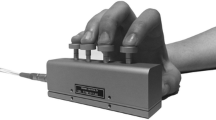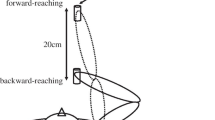Abstract
Both hand function [as seen through the coordination between grip force (GF) and load force (LF)] and the ability to produce a submaximal force quickly (i.e., neuromuscular quickness) are two important qualities of motor function that could be seriously affected by the presence of neurological diseases. Therefore, their quantitative assessment is very important in clinical settings. Within this study, we aimed to develop, standardize, and measure the within-session reliability of a clinically meaningful test that assesses both hand function and neuromuscular quickness simultaneously. Thirteen healthy young adults produced around 90 rapid isometric LF pulses to varying submaximal magnitudes by either pulling down or pulling up on an externally fixed GF- and LF-measuring device. Results revealed high indices of force coordination (i.e., GF scaling as assessed by GF/LF and GF coupling as assessed by maximum cross-correlation between GF and LF) in both force directions, while GF coupling was higher in downward than in upward direction (p < 0.001). Regarding the indices of neuromuscular quickness (i.e., the regression parameters obtained from the relationship between peak force and it’s rate of development and half-relaxation time), results, in general, revealed a higher slope (named as rate of force development scaling factor; p < 0.01), similar R 2 (p > 0.05), and shorter half-relaxation time (p < 0.05) for LF than for GF. Furthermore, all of the selected variables showed moderate to excellent within-session reliability with only 45 pulses. Findings suggest that brief force production tasks should be further evaluated as clinical tests of hand function and neuromuscular quickness in various populations.




Similar content being viewed by others
References
Bearlehman J, Abreu BC (1989) Evaluating the hand—issues in reliability and validity. Phys Ther 69:1025–1033
Bellumori M, Jaric S, Knight CA (2011) The rate of force development scaling factor (RFD-SF): protocol, reliability, and muscle comparisons. Exp Brain Res 212:359–369. doi:10.1007/s00221-011-2735-7
Bellumori M, Jaric S, Knight CA (2013) Age-related decline in the rate of force development scaling factor. Mot Control 17:370–381
Birznieks I, Jenmalm P, Goodwin AW, Johansson RS (2001) Encoding of direction of fingertip forces by human tactile afferents. J Neurosci 21:8222–8237
Callahan DM, Kent-Braun JA (2011) Effect of old age on human skeletal muscle force-velocity and fatigue properties. J Appl Physiol 111:1345–1352. doi:10.1152/japplphysiol.00367.2011
Casartelli NC, Lepers R, Maffiuletti NA (2014) Assessment of the rate of force development scaling factor for the hip muscles. Muscle Nerve 50:932–938. doi:10.1002/mus.24229
Chou LW, Palmer JA, Binder-Macleod S, Knight CA (2013) Motor unit rate coding is severely impaired during forceful and fast muscular contractions in individuals post stroke. J Neurophysiol 109:2947–2954. doi:10.1152/jn.00615.2012
Corcos DM, Chen CM, Quinn NP, McAuley J, Rothwell JC (1996) Strength in Parkinson’s disease: relationship to rate of force generation and clinical status. Ann Neurol 39:79–88. doi:10.1002/ana.410390112
de Freitas PB, Jaric S (2009) Force coordination in static manipulation tasks performed using standard and non-standard grasping techniques. Exp Brain Res 194:605–618
de Freitas PB, Lima KCA (2013) Grip force control during simple manipulation tasks in non-neuropathic diabetic individuals. Clin Neurophysiol 124:1904–1910. doi:10.1016/j.clinph.2013.04.002
de Freitas PB, Krishnan V, Jaric S (2007) Force coordination in static manipulation tasks: effects of the change in direction and handedness. Exp Brain Res 183:487–497. doi:10.1007/s00221-007-1064-3
Fellows SJ, Noth J, Schwarz M (1998) Precision grip and Parkinson’s disease. Brain 121(Pt 9):1771–1784
Flanagan JR, Wing AM (1995) The stability of precision grip forces during cyclic arm movements with a hand-held load. Exp Brain Res 105:455–464
Freund HJ, Budingen HJ (1978) Relationship between speed and amplitude of fastest voluntary contractions of human arm muscles. Exp Brain Res 31:1–12
Gordon J, Ghez C (1987) Trajectory control in targeted force impulses. II. Pulse height control. Exp Brain Res 67:241–252
Gorniak SL, Alberts JL (2013) Effects of aging on force coordination in bimanual task performance. Exp Brain Res 229:273–284. doi:10.1007/s00221-013-3644-8
Gorniak SL, Zatsiorsky VM, Latash ML (2010) Manipulation of a fragile object. Exp Brain Res 202:413–430. doi:10.1007/s00221-009-2148-z
Hager-Ross C, Cole KJ, Johansson RS (1996) Grip-force responses to unanticipated object loading: load direction reveals body- and gravity-referenced intrinsic task variables. Exp Brain Res 110:142–150
Hermsdorfer J, Hagl E, Nowak DA, Marquardt C (2003) Grip force control during object manipulation in cerebral stroke. Clin Neurophysiol 114:915–929
Jaric S, Uygur M (2013) Assessment of hand function through the coordination of contact forces in manipulation tasks. J Hum Kinet 36:5–15. doi:10.2478/hukin-2013-0001
Johansson RS, Westling G (1984) Roles of glabrous skin receptors and sensorimotor memory in automatic control of precision grip when lifting rougher or more slippery objects. Exp Brain Res 56:550–564
Krishnan V, de Freitas PB, Jaric S (2008) Impaired object manipulation in mildly involved individuals with multiple sclerosis. Mot Control 12:3–20
Nowak DA, Hermsdorfer J (2005) Grip force behavior during object manipulation in neurological disorders: toward an objective evaluation of manual performance deficits. Mov Disord 20:11–25
Park JH, Stelmach GE (2007) Force development during target-directed isometric force production in Parkinson’s disease. Neurosci Lett 412:173–178. doi:10.1016/j.neulet.2006.11.009
Portney LG, Watkins MP (2008) Foundations of clinical research: applications to practice, 3rd edn. Prentice Hall, Upper Saddle River
Sarlegna FR, Baud-Bovy G, Danion F (2010) Delayed visual feedback affects both manual tracking and grip force control when transporting a handheld object. J Neurophysiol 104:641–653. doi:10.1152/jn.00174.2010
Suzuki T, Sugawara K, Takagi M, Higashi T (2015) Excitability changes in primary motor cortex just prior to voluntary muscle relaxation. J Neurophysiol 113:110–115. doi:10.1152/jn.00489.2014
Toma K, Honda M, Hanakawa T et al (1999) Activities of the primary and supplementary motor areas increase in preparation and execution of voluntary muscle relaxation: an event-related fMRI study. J Neurosci 19:3527–3534
Uygur M, de Freitas PB, Jaric S (2010) Effects of varying the load force range and frequency on force coordination in static manipulation. Neurosci Lett 475:115–119. doi:10.1016/j.neulet.2010.03.063
Uygur M, Jin X, Knezevic O, Jaric S (2012) Two-dimensional static manipulation tasks: does force coordination depend on change of the tangential force direction? Exp Brain Res 222:365–375. doi:10.1007/s00221-012-3221-6
Uygur M, Prebeg G, Jaric S (2014) Force control in manipulation tasks: comparison of two common methods of grip force calculation. Mot Control 18:18–28. doi:10.1123/mc.2012-0121
Van Cutsem M, Duchateau J, Hainaut K (1998) Changes in single motor unit behaviour contribute to the increase in contraction speed after dynamic training in humans. J Physiol Lond 513:295–305
Wierzbicka MM, Wiegner AW, Logigian EL, Young RR (1991) Abnormal most-rapid isometric contractions in patients with Parkinsons-disease. J Neurol Neurosurg Psychiatry 54:210–216. doi:10.1136/jnnp.54.3.210
Author information
Authors and Affiliations
Corresponding author
Ethics declarations
Conflict of interest
The authors declare that they have no conflict of interest.
Rights and permissions
About this article
Cite this article
Haberland, K., Uygur, M. Simultaneous assessment of hand function and neuromuscular quickness through a static object manipulation task in healthy adults. Exp Brain Res 235, 321–329 (2017). https://doi.org/10.1007/s00221-016-4797-z
Received:
Accepted:
Published:
Issue Date:
DOI: https://doi.org/10.1007/s00221-016-4797-z




